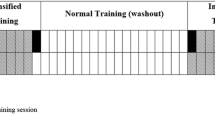Abstract
Acute plasma GH response to prolonged (1 h) near-maximal exercise was studied in 7 elite cyclists (6 males, 1 female; mean age±SE: 24.9±1.4 yr) during a routine training session on an uphill track (length: 22.0 km, average slope: 4.39%) and during a recovery (REC) period of 60 min from the end of exercise. The training session entailed a warming-up (WARM) phase of about 20 min at 63% of individual maximal heart rate (HRmax) followed by a high intensity exercise (HIE) phase of about 60 min at 90-92% of HRmax. GH resting values averaged 0.2±0.06 ng/ml; average GH concentration attained a maximal value (21.5±3.3 ng/ml, range: 11.0-38.2 ng/ml) between 20 and 40 min of HIE and significantly decreased thereafter (p=0.01), although exercise intensity was unchanged in the following period (p=0.14). After WARM, GH concentrations were significantly lower than peak values (p=0.05). During REC, GH levels steadily decreased, attaining a value of 2.6±0.8 ng/ml 60 min after the end of exercise. It was concluded that during prolonged and sustained exercise on-the-field in cyclists, GH value determined at the end of the bout may not correspond to the maximal value, which can be observed after 20 to 40 min of near-maximal exercise.
Similar content being viewed by others
References
Jenkins PJ. Growth hormone and exercise. Clin Endocrinol (Oxf) 1999, 50: 683–9.
Wideman L, Weltman JY, Hartman MK, Veldhuis D, Weltman A. Growth hormone release during acute and chronic aerobic and resistance exercise. Sports Med 2002, 32: 987–1004.
Pritzlaff CJ, Wideman L, Weltman JY, et al. Impact of acute exercise intensity on pulsatile growth hormone release in men. J Appl Physiol 1999, 87: 498–504.
Pritzlaff-Roy CJ, Wideman L, Weltman JY, et al. Gender governs the relationship between exercise intensity and growth hormone release in young adults. J Appl Physiol 2002, 92: 2053–60.
Bunt JC, Boileau RA, Bahr JM, Nelson R. Sex and training differences in human growth hormone during prolonged exercise. J Appl Physiol 1986, 61: 1796–801.
Felsing NE, Brasel JA, Cooper DM. Effect of low and high intensity exercise on circulating growth hormone in men. J Clin Endocrinol Metab 1992, 75: 157–62.
Kozlowski S, Chwalbinska-Moneta J, Vigas M, Uscilko H, Nazar K. Greater serum GH response to arm than to leg exercise performed at equivalent oxygen uptake. Eur J Appl Physiol 1983, 52: 111–35.
Kanaley JA, Weltman JY, Veldhuis JD, Rogol AD, Hartman ML, Weltman A. Human growth hormone response to repeated bouts of aerobic exercise. J Appl Physiol 1997, 83: 1756–61.
Lassarre C, Girard F, Durand J, Raynaud J. Kinetics of human growth hormone during submaximal exercise. J Appl Physiol 1974, 37: 826–30.
Raynaud J, Capderou A, Martineaud JP, Bordachar B, Durand J. Intersubject variability in growth hormone time course during different types of work. J Appl Physiol 1983, 55: 1682–7.
Thompson DL, Weltman JY, Rogol AD, Metzger DL, Veldhuis JD, Weltman A. Cholinergic and opioid involvement in release of growth hormone during exercise and recovery. J Appl Physiol 1993, 75: 870–8.
Weltman A, Snead D, Stein P, et al. Reliability and validity of a continuous incremental treadmill protocol for the determination of lactate threshold, fixed blood lactate concentrations and VO2 max. Int J Sports Med 1990, 11: 26–32.
Weltman A, Weltman JY, Schurrer R, Evans WS, Veldhuis JD, Rogol AD. Endurance training amplifies the pulsatile release of growth hormone: effects of training intensity. J Appl Physiol 1992, 72: 2188–96.
Wideman L, Weltman JY, Shah N, Story S, Veldhuis JD, Weltman A. Effects of gender on exercise-induced growth hormone release. J Appl Physiol 1999, 87: 1154–62.
Ehrnborg C, Lange KHW, Dall R, et al., on the behalf of the GH- 2000 study group. The growth hormone/insulin-like growth factor- I axis hormones and bone markers in elite athletes in response to a maximum exercise test. J Clin Endocrinol Metab 2003, 88: 394–401.
Wallace JD, Cuneo RC, Baxter R, et al. Responses of the growth hormone (GH) and insulin-like growth factor axis to exercise, GH administration, and GH withdrawal in trained adult males: a potential test for GH abuse in sport. J Clin Endocrinol Metab 1999, 84: 3591–601.
Author information
Authors and Affiliations
Corresponding author
Rights and permissions
About this article
Cite this article
Lafortuna, C.L., Marinone, P.G., Ottolini, S. et al. GH responses to a near-maximal exercise training session on-the-field in cyclists. J Endocrinol Invest 26, RC12–RC14 (2003). https://doi.org/10.1007/BF03347347
Accepted:
Published:
Issue Date:
DOI: https://doi.org/10.1007/BF03347347




